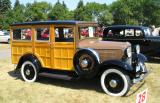|
|||||||
| Sponsored Links (Register now to hide all advertisements) |
|
|
 |

|
Thread Tools | Display Modes |
|
|
|
|
#1 |
|
Senior Member
Join Date: May 2010
Location: southeastern Michigan
Posts: 10,601
|
I deleted my earlier vote and did some homework, which often is more reliable than relying on one's memory. Page 114 of the August, 1933 Ford Service Bulletin reaffirms the Model A Service Bulletin information cited above by Lawrie. I quote: "The grease retainers in the axle housings and torque tube (B-4245) should always be replaced when axle is overhauled. Install retainer in torque tube with sharp edge of leather toward the universal joint. Install retainers the axle housings with sharp edge of leather toward the differential." (The seal of original retainers was made of leather.)
So, the male/female rule applies to the drive shaft seal, but not to the axle housing seals. |
|
|

|
|
|
#2 | |
|
Senior Member
Join Date: May 2010
Location: near Washington, DC
Posts: 589
|
Quote:
For me, it's a bit hard to interpret the original ("sharp edge") directions quoted above. The sealing edge of today's seal has a symmetrical V-shaped sharp edge. As can be seen in Norm's original post, the seal has an open side (photo #1) and a closed side (photo #2). A higher pressure on the open side will increase the sealing effectiveness and vice versa. Thus, for me, it would be a bit clearer to refer to the open or closed sides when describing the procedures and rationales for orientation of the seals.
__________________
Those who do not move do not die, but are they not already dead? |
|
|
|

|
| Sponsored Links (Register now to hide all advertisements) |
|
|
 |
«
Previous Thread
|
Next Thread
»
|
|
| Sponsored Links (Register now to hide all advertisements) |
|
|
All times are GMT -5. The time now is 03:12 PM.





 Hybrid Mode
Hybrid Mode
